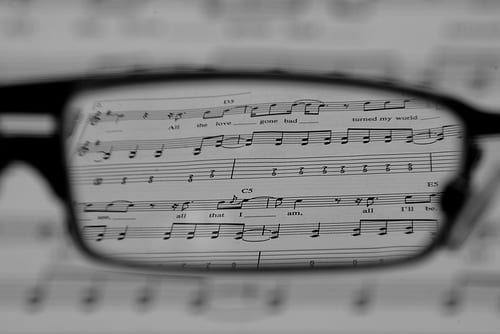 A good musician knows that performing a piece is not just about recognizing black and white notes on the page and hitting the appropriate keys – expressing the emotions through dynamics and phrasing is where the fun really begins! And if you’re learning a new piece, a few key details can give you a look into what the composer had in mind.
A good musician knows that performing a piece is not just about recognizing black and white notes on the page and hitting the appropriate keys – expressing the emotions through dynamics and phrasing is where the fun really begins! And if you’re learning a new piece, a few key details can give you a look into what the composer had in mind.
A few months back we published an article about beginner sight reading that struck a chord (yes, pun intended) for many of our readers, and this article takes it one step further. Sight reading as a technique can make a world of difference as you progress in your music lessons, especially if you’re preparing for auditions, as many require a sight reading portion.
We love this article from PianoCareer.com, exploring some of those key details to keep in mind, whether you’re playing the piano, violin or any other instrument. Here are the first four things to consider:
1. The genre. First of all, analyze the genre: it’s obvious that an Etude has a different meaning than a Nocturne, a Ballade, a Prelude or a Barcarole. Study the history of each musical genre – this way you’ll learn a LOT about the meaning of the pieces written in that particular genre. For example, when you’ll play a Minuet you’ll be aware of its gracious dancing character; when you’ll play a Toccata – you’ll want to create a sparkling, dynamic character; an Impromptu will immediately make you think about a free improvisation; and so on!
2. The tempo and character indications. Take a look at the indication at the beginning of the piece. Many composers, besides writing the tempo (Largo, Adagio, Moderato, Andante, Allegro, Presto, etc.) also indicate the main character – for example giocoso, cantabile, dolce, grave, maestoso, lamentoso, etc. These indications are immediately ‘shifting’ our focus to the needed feeling and atmosphere!
3. The style of the composer. Even if two pieces have the same title or genre – they may still have entirely different characters – being written in different epochs, by different composers. For example, let’s compare a Prelude by Bach with a Prelude by Chopin, or a Prelude by Rachmaninoff with a Prelude by Debussy! Yes, the genre is the same – but the character is inevitably different, being a reflection of the composer’s unique approach (and also of the style of the epoch).
4. The time signature. Time signatures are extremely suggestive when it comes to the character and meaning of the music. A 3/4 time signature (or 3/8, 6/8, 9/8) is usually indicating a dancing character; 2/4, 4/4, 2/2 suggests a more ‘balanced’ structure. There are also unusual time signatures like 7/8, 1/4, 5/8 – usually being inspired from folk music – which again tells us a lot about the meaning of the piece!
Continue reading Ilinca’s article here.
Readers, what do you think? What helps you when you’re sight reading a new piece? Leave a comment below, or head over to our Facebook page and share your thoughts!
Learn more insider advice for musicians – sign up for email updates here!
You might also like…
– Fine-Tune the Way You Learn Music
– How to Practice the Piano… Outside of the Studio
– 5 Excuses for Not Practicing – And How to Overcome Them
Suzy S.
